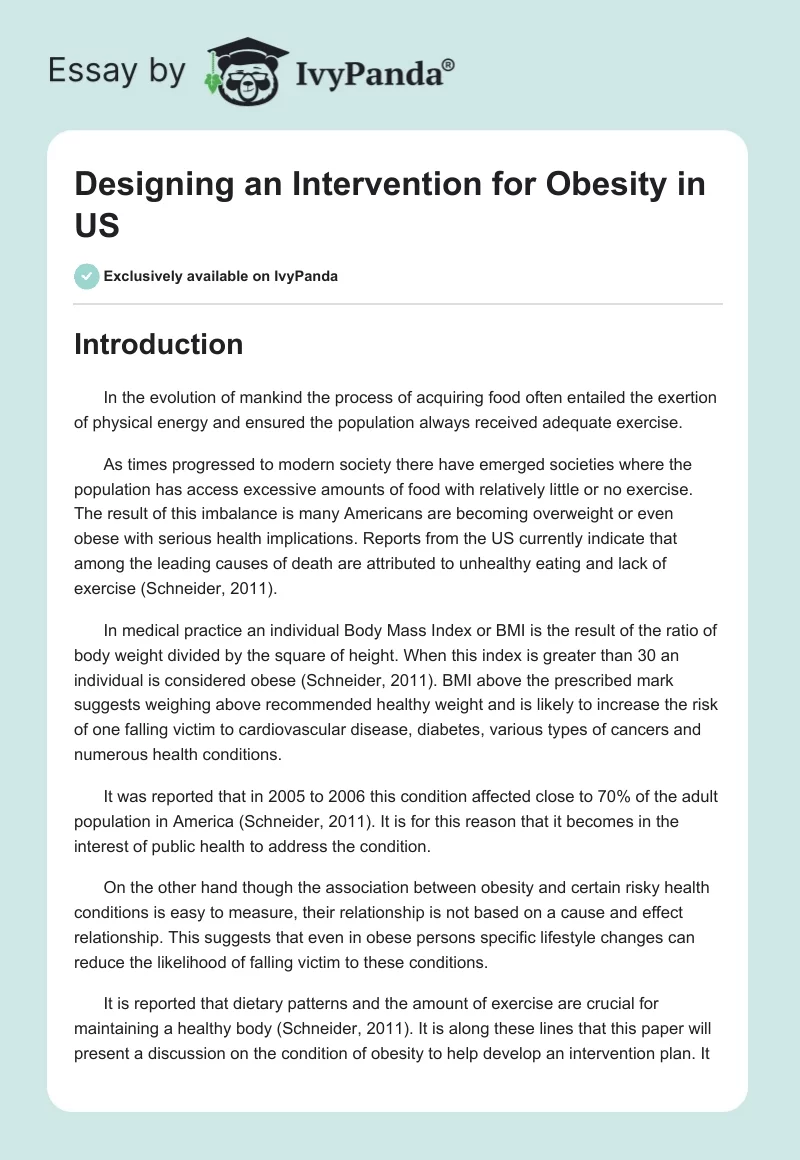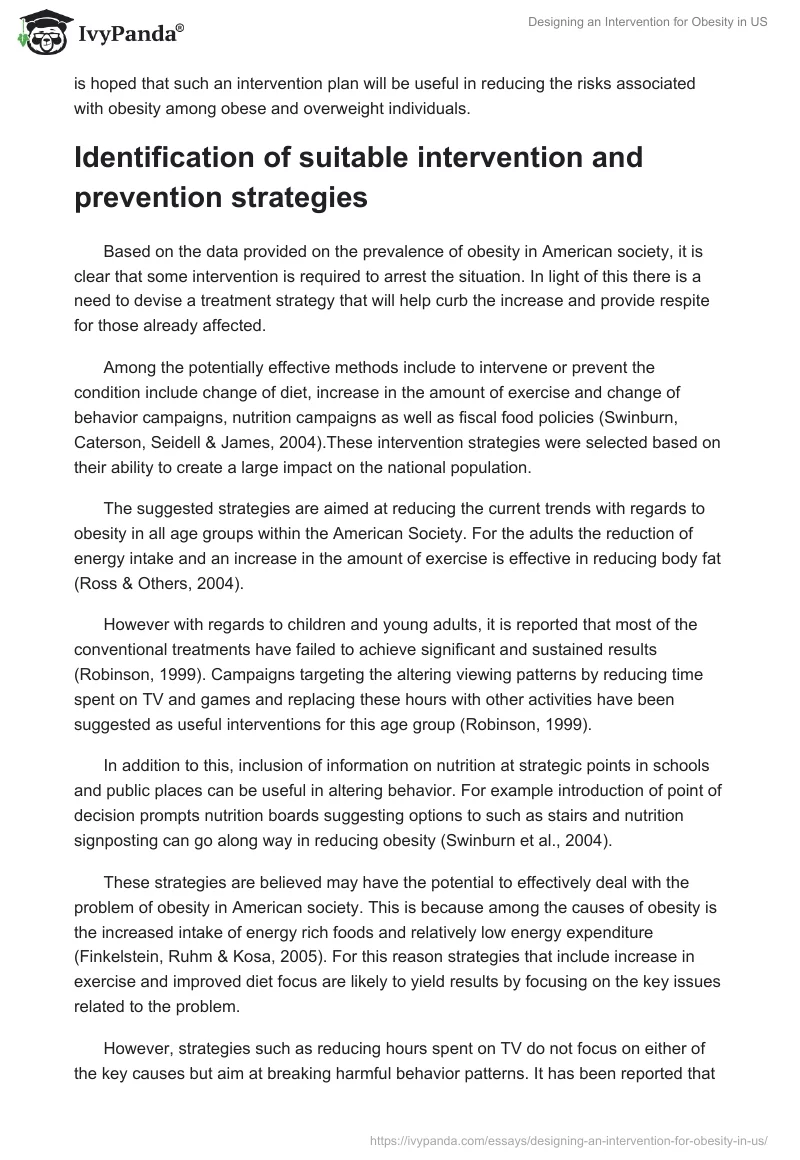Introduction
In the evolution of mankind the process of acquiring food often entailed the exertion of physical energy and ensured the population always received adequate exercise.
As times progressed to modern society there have emerged societies where the population has access excessive amounts of food with relatively little or no exercise. The result of this imbalance is many Americans are becoming overweight or even obese with serious health implications. Reports from the US currently indicate that among the leading causes of death are attributed to unhealthy eating and lack of exercise (Schneider, 2011).
In medical practice an individual Body Mass Index or BMI is the result of the ratio of body weight divided by the square of height. When this index is greater than 30 an individual is considered obese (Schneider, 2011). BMI above the prescribed mark suggests weighing above recommended healthy weight and is likely to increase the risk of one falling victim to cardiovascular disease, diabetes, various types of cancers and numerous health conditions.
It was reported that in 2005 to 2006 this condition affected close to 70% of the adult population in America (Schneider, 2011). It is for this reason that it becomes in the interest of public health to address the condition.
On the other hand though the association between obesity and certain risky health conditions is easy to measure, their relationship is not based on a cause and effect relationship. This suggests that even in obese persons specific lifestyle changes can reduce the likelihood of falling victim to these conditions.
It is reported that dietary patterns and the amount of exercise are crucial for maintaining a healthy body (Schneider, 2011). It is along these lines that this paper will present a discussion on the condition of obesity to help develop an intervention plan. It is hoped that such an intervention plan will be useful in reducing the risks associated with obesity among obese and overweight individuals.
Identification of suitable intervention and prevention strategies
Based on the data provided on the prevalence of obesity in American society, it is clear that some intervention is required to arrest the situation. In light of this there is a need to devise a treatment strategy that will help curb the increase and provide respite for those already affected.
Among the potentially effective methods include to intervene or prevent the condition include change of diet, increase in the amount of exercise and change of behavior campaigns, nutrition campaigns as well as fiscal food policies (Swinburn, Caterson, Seidell & James, 2004).These intervention strategies were selected based on their ability to create a large impact on the national population.
The suggested strategies are aimed at reducing the current trends with regards to obesity in all age groups within the American Society. For the adults the reduction of energy intake and an increase in the amount of exercise is effective in reducing body fat (Ross & Others, 2004).
However with regards to children and young adults, it is reported that most of the conventional treatments have failed to achieve significant and sustained results (Robinson, 1999). Campaigns targeting the altering viewing patterns by reducing time spent on TV and games and replacing these hours with other activities have been suggested as useful interventions for this age group (Robinson, 1999).
In addition to this, inclusion of information on nutrition at strategic points in schools and public places can be useful in altering behavior. For example introduction of point of decision prompts nutrition boards suggesting options to such as stairs and nutrition signposting can go along way in reducing obesity (Swinburn et al., 2004).
These strategies are believed may have the potential to effectively deal with the problem of obesity in American society. This is because among the causes of obesity is the increased intake of energy rich foods and relatively low energy expenditure (Finkelstein, Ruhm & Kosa, 2005). For this reason strategies that include increase in exercise and improved diet focus are likely to yield results by focusing on the key issues related to the problem.
However, strategies such as reducing hours spent on TV do not focus on either of the key causes but aim at breaking harmful behavior patterns. It has been reported that the change in pattern alone without inclusion of suitable alternative activity is unlikely to yield favorable results (Robinson, 1999). It is for this reason that these strategies are only suggested in collaboration with other strategies.
Recommendation and Priorities for the intervention/policy
Based on the findings on the possible results of various interventions this report recommends the implementation of fiscal food policy in collaboration with increased dietary awareness campaigns. This intervention was selected based on a number of considerations that found it most suited for the purpose.
It has been reported that socioeconomic status plays a significant role with regards to obesity. The socioeconomic status of an individual is measured by assessing level of income and educational level of the individual. Based on socioeconomic status it is more likely for individuals with lower status to become obese than those of higher status (Swinburn et al., 2004). Among the reasons behind this include the fact that lower status reduces choices available to the individual.
Based on this it is clear that if food prices were regulated to make fresh relatively expensive foods more affordable and processed foods more expensive a change is likely to be observed. It has been reported that the difference in prices of fresh produce in relation to processed foods is among the reasons for current eating trends (Finkelstein et al., 2005).
Also it has been reported that low socioeconomic status is the main driver behind obesity. This is evident by the fact that the majority of obese individuals come from ethnic minorities. Individuals in this social category are limited in terms of the options available when in comes to planning for food. In addition to that due to their low income they are limited in the degree of outdoor physical activity they can undertake (Finkelstein et al., 2005).
This position suggests that unless some remedial action is taken this category is bound to be stuck indoors with TV as their only option for entertainment. It may be assumed that this position is the cause of the prevalence of obesity among them in the first place. The individuals and communities in this category were granted priority in this recommendation owing to the fact that they are the group facing the greatest risk by virtue of obesity.
Implementation of the intervention and evaluation strategy
It is believed that this intervention can best be implemented by the government using the price policy instruments such as taxation to influence buying patterns. This scheme is likely to be successful as it is reported that food prices have marked influence on spending patterns.
This is illustrated by the fact that prices of sugars and sweets, fats and oils and carbonated drinks declined by 46%, 35% and 20% respectively during the period 1985-2000. In the same period fresh fruits and vegetable, fish and dairy produce prices rose by 118%, 77% and 56% respectively (Finkelstein et al., 2005). These trends imply consistency with the increase in consumption of foods made from processed sugars and fats in the same duration.
It has been reported that with a government directive imposing 17.5% value added tax could 900-1000 deaths in the UK could be averted (Swinburn et al., 2004). This is based n the reduced demand on the processed foods targeted by the taxation. However, due to the contentious nature of such legislation governments are often slow at their implementation. The main barriers being faced are the petitions that will be put in the way of such legislation by large multinational corporations.
However, it is possible to impose a smaller tax on high volume foods such as soft drinks as is currently applied in some areas of the US and Canada (Swinburn et al., 2004). In this case the proceeds from this can be used in promoting health initiatives. In either case it is expected that the consumption of these food groups will reduce and with them the problems associated with obesity.
Communication Strategy
The goal of any communication strategy is to convey the desired message. With regard to a public health campaign it is assumed that when the desired behavior is exhibited in the target population the strategy has been successful.
It has been suggested that before change takes place in individuals four stages are evident i.e. pre contemplation (no intention to change), contemplation (intent to change), preparation, action and maintenance (Noar, Benac & Harris, 2007). It has been noted that a well crafted campaign is required to attain this and it is expected that the material propagated be crafted in manner that can see the achievement of these ends.
The main components that have been identified for the dissemination of this information are TV, newsletters, pamphlets, etc. Given that this is a national agenda it is essential to get a wide coverage and these two media promise the widest coverage within the nation.
It has been suggested that for successful results it is crucial to reduce the duration between the intervention and the follow up (Noar, Benac & Harris, 2007). For this reason one of the greatest barriers faced in the communication is the access to the huge financial resources required to craft an appropriate message, prepare material and establish suitable intervals for the dissemination of the information.
References
Finkelstein, E. A., Ruhm, C. J. & Kosa, K. M. (2005). Economic Causes and Consequences of Obesity. The Annual Review on Public Health, 26, 239-257.
Noar, S. M., Benac, C. N. & Harris, M. S. (2007). Does Tailoring Matter? Meta Analytic Review of Tailored Print Health Behavior Change Interventions. Psychological Bulletin, 133(4), 673-693.
Robinson, T. N. (1999). Reducing Children’s Television Viewing to Prevent Obesity. The Journal of the American Medical Association, 282, 1551-1567.
Ross, R. & Others. (2004). Exercise Induced Reduction in Obesity and Insulin Resistance in Women: A Randomized Controlled Study. Obesity Research, 12(5), 789-798.
Swinburn, B. A., Caterson, I., Seidell, J. C. & James, W. P. T. (2004). Diet, Nutrition and the Prevention of Excess Weight Gain and Obesity. Public Health Nutrition, 7(1A), 123-146.


